The problem with the world is that everyone is a few drinks behind
The title of this article is a famous quote from Humphrey Bogart which couldn’t be more apt right now. Everyone has a favourite reopening trade. With some travel names up 100% from their lows(1) and casinos partially recovered, buying into some of these names before earnings normalise has been a relatively successful strategy. Although up from its lows, a re-opening name we remain constructive on is United Malt Group (UMG), which having demerged from GrainCorp (GNC) in March 2020 has endured a challenging first 12 months of listed life.
This writer, having lived in an Adelaide bubble through COVID, has experienced first-hand the burgeoning popularity of craft breweries such as Pirate Life, Big Shed, and Little Bang. Adelaide (Perth and Brisbane) perhaps before other cities in Australia, and definitely before most of the US, has experienced the rebound in on-premise consumption. COVID enhanced two key themes that personify the craft beer movement: localisation and community.
No one knows the exact shape of the recovery curve for (US) on premise / craft beer consumption but having experienced a leading analogue in Adelaide this writer believes we will at least return to normalised (FY19) levels within the next 12 months, if not overshooting as pent-up demand is released. Who doesn’t need a drink after being cooped up at home?
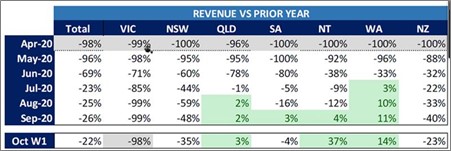
Source: Australia Venue Co. Pub Turnover to October 2020
Apart from a normalisation in earnings, we are attracted to the following aspects of an investment in UMG:
- Ongoing penetration of craft
- Strategic nature of assets
- Management alignment
- Historic demerger outperformance
- Stability in historic earnings (pre COVID obviously) and de-gearing potential
- Private Equity (PE) Interest
Background
UMG is the fourth largest maltster globally with ~1.25Mtpa of processing capacity, operating at around 95% utilisation (pre-COVID) with 13 plants across Canada, the USA, Australia and the UK.
For around 600 customers, UMG handles the barley procurement, processing and handling of malt, as well as the sale of co-products. UMG also operates an international distribution/ warehousing business, through a network of 21 warehouses, providing a full service offering to around 7,000 (craft) brewers and distillers including malt, hops, yeast, adjuncts and related products. At the time of demerger, UMG had some 970 employees globally with operational headquarters in Vancouver, Washington. Pre COVID revenue was split between the following customer mix and locations.

Source: UMG Information Memorandum and Scheme Booklet
It is worth noting that global beer consumption has been quite flat between 2014 and 2018(3) however craft production increased at a CAGR rate of 10.7% during that time (4). Craft beer is particularly important for the malt industry due to higher malt inclusion (~3x the requirement of mainstream beer), general requirement for higher quality and also a desire for specialty malts. UMG is established as one of the leading suppliers to the craft beer industry. In 2020 US overall beer volumes we estimated to be down ~3% with craft volumes down ~9% and sales revenue down 22% (4). Craft (which over-indexes to on-premise) was materially impacted by lockdowns, moreso than the major brewers. As discussed below as things ‘normalise’ we expect a return of craft volumes, with further tailwinds for craft from localisation trends particularly in underpenetrated states.
Strategic assets
Although there are many smaller players in the malting industry, very few maltsters have the required scale to service national brewers and the ever-changing requirements of craft brewers. Approximately three-quarters of global malt capacity is owned by commercial maltsters with the four largest (UMG, Boortmalt, Malteries Soufflet and Malteurop) accounting for around 35% of global production. UMG’s footprint throughout North America, Australia and the UK is strategically located across major barley regions in proximity to critical transport infrastructure (roads, rail, and ports) which maximises efficiency in lowering transport costs.
UMG’s Warehouses and Distribution capabilities provide it the ability for a full service offering to craft customers, who were very reliant on the balance sheet of strong suppliers during COVID. This is enhanced by ~20 international craft distribution partnerships globally as well as an innovation centre in Vancouver, Washington which houses a pilot brewery enabling collaboration with customers. Having started to experiment with brewing ourselves this writer believes there is a level of incumbency with customers due to unique flavours and malt types creating a reluctance to change suppliers.
Management alignment
Upon demerger, MD, Mark Palmquist and Chairman, Graham Bradley made the decision to join UMG rather than GNC. A raft of factors would’ve played into this decision but we saw this initial move as a positive endorsement of the attractiveness of UMG.
Further to this, as noted in our article from last year(5) UMG directors have been very active in purchasing stock on market. At the time of our article, we noted 14 insider buys of UMG, which has since increased to 17. Although UMG has outperformed another consumer staple stock, A2M that saw Director selling over the past 12 months, shareholders (including these directors) are yet to see this insider activity translate to outperformance.
Historic demerger performance
We’ve all heard the Investment Banker spiel 1+1=3, but apparently 2–1>1, at least demergers have tended to outperform historically(6). Clearly most demergers don’t occur in the middle of a global pandemic, but one analyst report on the topic(7) has noted that for a demerger of similar size entities both generally underperform the market for ~6 months (tick here for UMG), however over the long term both stocks tend to outperform.
We do note that within the combined entity, GNC had struggled through drought potentially constraining focus and the capital afforded to UMG for growth opportunities like expansion into Mexico (and other regions), Warehouse CRM implementation, Perth Kiln upgrade, etc.
Grant Samuels's analysis within its GNC demerger scheme booklet indicated that demerged entities have generally outperformed the market within two years of listing (refer to the graph below). At the current juncture this appears to be unlikely for UMG.

Source: Chester Asset Management, IRESS
Financials
A couple of notes about UMG’s financials:
- EBITDA of UMG has shown a relatively steady profile between FY2016 to FY2019 from both a revenue and margin perspective particularly across Processing
- Revenue within warehousing has a greater skew to Craft beer customers and hence reflects the impact of stronger growth in craft vs mainstream beer in processing
- On our calculations cash conversion(8) has averaged >85% since FY2016
- As a separate entity UMG took on a greater share of debt, due to its steadier cash flows and despite the May 2020(9) capital raise still has an opportunity for de-gearing. Net Debt at 30/9/2020 stood at AUD262m ~1.7x EBITDA
- UMG is targeting a payout ratio of ~60% of NPAT going forward, this puts UMG on a dividend of 3.5-4% using Chester’s normalised earnings at current prices
- Capex ran above D&A in FY2016 and FY2017 with the ~AUD105m expansion of the malt plant in Pocatello, Idaho. Capex is again high in FY21 at ~AUD120m with the 79ktpa, GBP51m expansion of Scottish Malt facilities
- We expect UMG to continue to invest in growth opportunities but stay in business (SIB) to remain relatively low at between $25 million and $30 million a year.
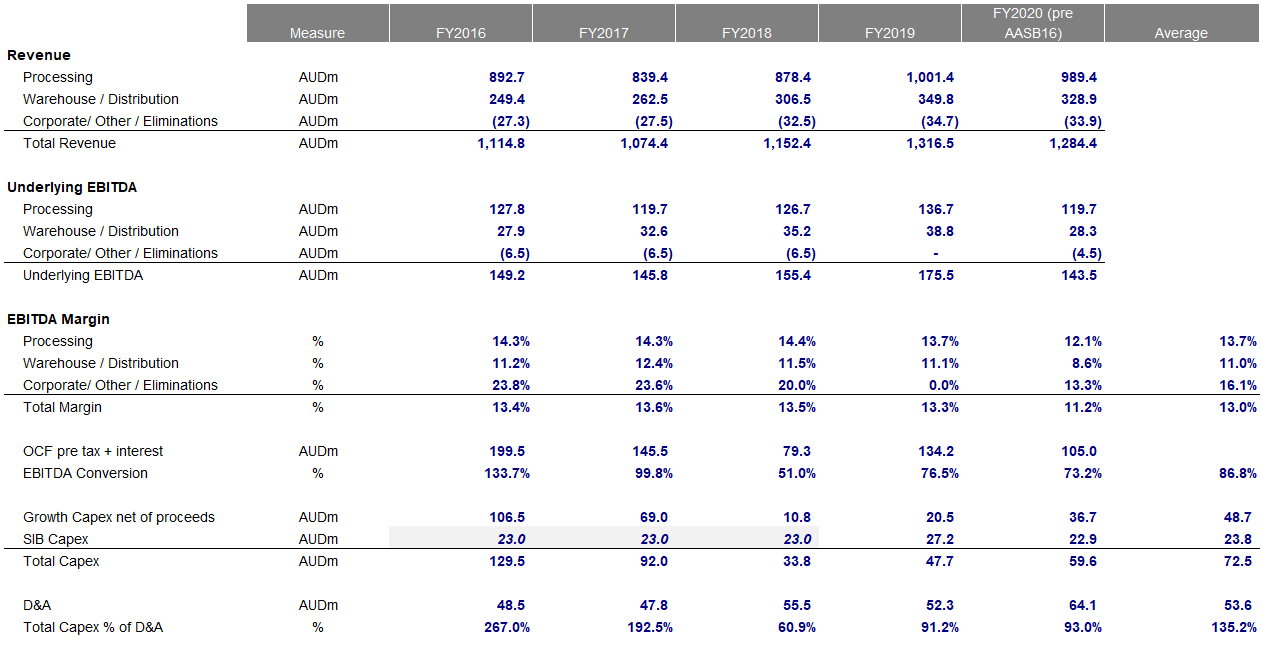
Source(s): UMG Information Memorandum and Scheme Booklet, UMG FY2020 accounts, Chester Asset Management
Private Equity
This is a quote directly from the UMG Information Memorandum, highlighting one of the advantages of the demerger of GNC: “after the Demerger, there will remain the potential for GrainCorp, UMG or other GNC portfolio businesses to be sold to a third party potentially delivering a control premium”.
Malt would have been a major consideration for the failed GNC takeover bid by Long Term Asset Partners in December 2018, so there has been historical interest in acquiring the business. Whether planted by motivated shareholders or genuine, the Australian Financial Review and The Australian seem to wheel out the same article every three months regarding private equity interest in the business (10). With the level of PE deal flow seemingly accelerating in a world of cheap money and surplus liquidity, we still believe the potential exists for suitors to be interested in UMG.
Normalisation
As discussed UMG’s FY20 and FY21 earnings have been materially impacted by COVID and the disruption to on-premise consumption. This has resulted in both volume and mix shift impacts, as the craft market segment was more materially impacted by COVID. Our understanding is that around 40% of craft sales pre-COVID were on-premise vs around 20% for mainstream beer.
Notably, when we model UMG (refer to our valuation below) we arrive at a normalised EBITDA figure of $185 million (post AASB16), which is above FY22 consensus. Previously we have published notes showing upgrade candidates. This isn’t specifically one of those notes, as there are many moving parts and we can’t be too specific: the timing of recovery (given potential vaccine delays and further lockdowns) and Scottish expansion ramp-up. However, we do believe when things reopen UMG earnings should revert to a figure based on FY19 (normalised) due to the following factors:
1. Contract structure (margins)
Historical passthrough mechanisms for barley and longer-term contracts with customers provide a reasonably predictable margin (when operating closer to full utilisation).
2. Craft volumes returning (volumes/revenue)
The Brewers Association (US) is reporting US craft beer volumes down 9% in 2020 vs 2019 with dollar sales down 22%. This compares to overall beer volumes down only ~3%. Likely due to higher reliance for craft towards on-premise sales. Given the higher utilisation of malt and premium products, hence the higher value of craft customers, we believe the revenue and margin impacts have far exceeded volume impacts. Interestingly although US craft volumes were down in 2020 the number of craft breweries actually increased.

Source: Statista (with data from Brewer’s Association)
If we look to Australia as our leading analogue to recovery in the US, the two listed operators in Mighty Craft (MCL) and Good Drinks Australia (GDA) are quoting an expectation of Australian Craft sales + 7-10% in 2021.
3. Warehouse and Distribution Craft Leverage (revenue + margins)
For UMG's Warehouse and Distribution (W&D) segment, revenue is predominantly derived from craft. Hence we use US craft sales and production changes as an indicator of direction of growth for UMG. It appears to have been highly correlated over recent times with UMG W&D Revenue, although UMG has been overachieving, which could indicate increased market share in the US, or greater growth ex-US craft.


We further note that there is a degree of operating leverage in W&D earnings given the fixed costs of operating a warehouse. Completely theorectical but below we have completed an exercise considering what (variable) GM might be available if ~1/3 (AUD100m) of costs within the business are fixed. Our calculations equate to a GM of ~40%. Extending that further if craft volumes normalise back to FY2019 type levels we see a roughly AUD20-30m uplift in W&D revenues, AUD8-12m EBITDA at assumed 40% GM.
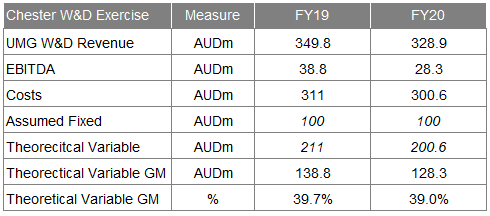
4. Strategic value to customers (margins + revenue)
UMG is strategically located close to customers in key barley growing regions proximal to transport. Hence we see them as engrained in customer supply chains.
I.e., We have used FY2019 EBITDA as a relatively normalised base and adjusted these for the relatively ‘known knowns’ of AASB16, Corporate Costs, FX, Scottish Expansion and Efficiencies.
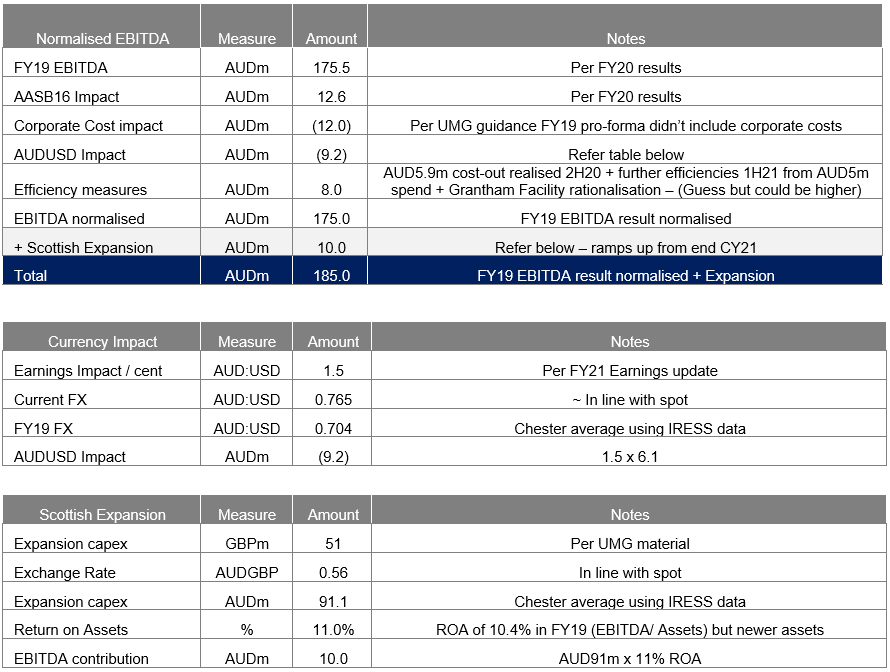
Source: Chester Asset Management, with data sourced from UMG announcements
Valuation
We have developed a detailed Discounted Cash Flow (DCF) of UMG that assumes a re-opening recovery in particular craft volumes (and also mainstream beer at events) that provides for a valuation of UMG of AUD5.20/share.
We believe deriving a normalised EBITDA, per our exercise above is important for performing an earnings capitalisation valuation as a cross check to our DCF. Grant Samuels within the GNC Demerger Scheme booklet IER suggested a figure of ~10x 1yr forward EBITDA as a reasonable base multiple (11x historic EBITDA, 9x 2yr forward). Notably there aren’t any listed public deals of relative comparison to UMG but the sale of Cargill’s malt business to French cereals co-operative Axereal is speculated to have occurred at close to 12x EBITDA(11). The business was a combination of 16 malthouses with combined capacity of 1.7Mtpa vs UMG at 1.25Mtpa hence represents a pretty good proxy for UMG under a takeover scenario. In the table below we combine these to provide a valuation per share.
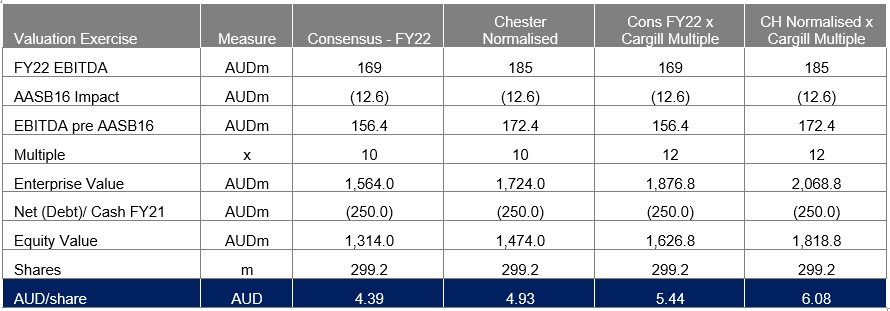
Source: Chester Asset Management, IRESS, Grant Samuel (UMG Information Memorandum and Scheme Booklet IER)
Conclusion
Hopefully, within the next 12 months, the world will have fewer problems.
(1) WEB, QAN, FLT(2) Major brewers, craft brewers and distillers
(3) and continues to underperform other alcohol categories such as seltzers and spirits
(6) Investment bankers are clearly smarter than this writer who is still working on the maths
(7) Macquarie Research Equities, “Australian Gas Light: Acquisitions, Restructures and Au Revoirs”, 1 November 2005
(8) Operating Cash flow pre-tax and interest / EBITDA
(9) AUD140m capital raise announced 14 May 2020
(10) The Australian reporting interest from the Carlyle Group in 6/12/202, the AFR reporting interest from Affinity, PEP, BGH
Not already a Livewire member?
Sign up today to get free access to investment ideas and strategies from Australia’s leading investors.
4 topics
5 stocks mentioned

